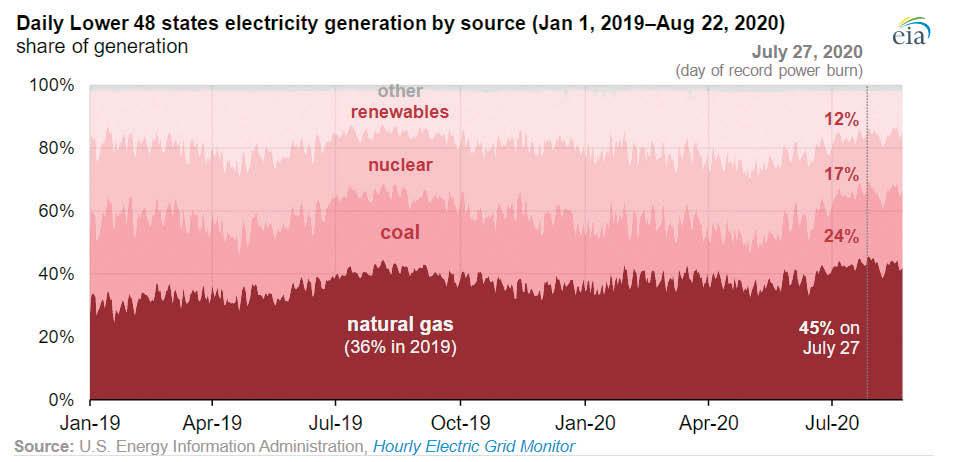
3 minute read
This Summer Was Monumental For Natural Gas, Ending With Record-Setting August
DYLAN LACROIX | U.S. Energy Information Administration
This summer, Americans received power by means of natural gas in record-breaking numbers. According to estimates from S&P Global Platts, electricity generated by natural gas reached a daily record high of 47.2 billion cubic feet as of July 27, 2020. That same day, natural gas-fired electricity in the lower 48 reached an all-time high of 316 gigawatts (GW).
Advertisement
As the United States continues to grapple with the effects of the COVID-19 pandemic, one thing is clear: natural gas provides affordable energy security to millions of Americans—and this summer’s record demand proves just that.
Daily Record Natural Gas Burn in July
July’s record-setting natural gas burn did not come as a surprise, either. Just a year prior, the United States set a similar record of 45.4 bcf on August 6, 2019.
According to U.S. Energy Information Administration reporting, the rise in power burn was associated with lower national prices for natural gas and expanded use of natural gas-fired capacity. Or, in other words, natural gas has proven itself to be an affordable, reliable and resilient option for powering American homes and businesses.
Natural gas is also becoming a vital component to alleviating financial strains for low-income households during the COVID-19 pandemic. A recent survey by Indiana University found that higher energy costs are disproportionately affecting low-income individuals and people of color—the same demographics positioned to benefit the most from increased natural gas-fired electricity.
Meeting Energy Demands
When looking at the portfolio of energy production in the contiguous United States, electricity generated by natural gas made up the largest share of all energy sources on July 27, 2020, roughly 45 percent. Second to natural gas, coal made up almost a quarter of U.S. energy sources at 24 percent, with nuclear and renewable energy at 17 and 12 percent, respectively.
Activation of natural gas as an energy source is a key competitive advantage when compared to other Record continued on page 4

sources of energy. As stated in the EIA’s most recent


“Natural gas is a key power generation resource because it has the flexibility to supply electricity at any time, including at times of peak demand. In contrast, some renewable energy technologies and nuclear power plants may be nondispatchable and not able to adjust their generation to meet load.”
Natural Gas Prices Rally
Prices of natural gas are soaring right along with demand. As more and more natural gas is utilized to create electricity, inventories across the United States are dwindling, creating sharp increases in prices for the month of August.
According to Barron’s, futures contracts for natural gas on August 31, 2020 soared to $2.63 million British thermal units, a 46 percent increase for the month. This increase nearly touched a record set in September 2009, when prices skyrocketed 62.6 percent.
Conclusion
In all aspects, the data shows that in order to reduce energy costs for millions of U.S. residents and provide stable energy security during peak demand seasons, natural gas must continue to be at the forefront of the U.S. energy development strategy. As this summer shows, natural gas is reliable, affordable, and the best option for powering U.S. homes and industries.
WilliamsToyotaLift Sales•Service•Rental•Parts
Supplyingthe MaterialHandlingIndustryfor Over40Years!

9462MainAveSE EastSparta,Ohio44626 Phone(330)866-2121 Fax(330)866-3701









